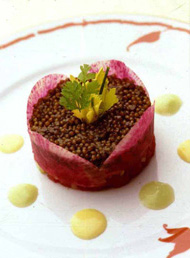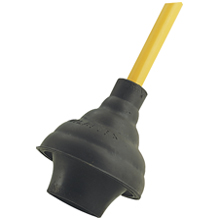Memorable Gourmet Experiences
Do you have an experience to share about entertaining guests, cooking for your family, fine food at a restaurant, purchasing specialty foods or beverages, or even meeting the food producers? Click here to send us your story and you may see it published here. We’ll start off with two from our own staff. Ours just happen to be mishaps—perhaps your memorable stories are more pleasurable—like having Joel Robuchon ask for your cheesecake recipe!
Tale #3: Winston Churchill Cold Duck
Karen Hochman
New York, NY
Cold Duck is something some NIBBLE readers may have tasted in high school or college, but not since—a sweet brew, generally made with inferior wines. Food dictionaries describe it as “a pink sparkling wine that is a mixture of Champagne, sparkling Burgundy and sugar, traced back to the Bavarian practice of mixing bottles of previously opened Champagne with cold sparkling Burgundy so the Champagne wouldn’t be wasted.” The mixture was called kalte ende (“cold end”); over the years, ende transliterated to ente, “duck.” The wines used to make cold duck are often of inferior quality.
When I went to wine school in Paris many years ago, I was taught a much nicer food legend—perhaps true, although as a food writer, I find that even the “true” origin of foods often turns out to be legend—as the genesis of the “practice”:
A count (or perhaps other designation of royalty, I can’t remember) was hosting a hunting party; when the group returned for lunch, his butler gave the count the bad news that that they had only half as much Champagne needed to serve all of the guests, and half as much Burgundy. The count solved the problem by mixing them together into a “kalte ende” (cold mixture of what was left in the cellar), which subsequently got transliterated as “kalte ente,” cold duck.
Since then, at the end of some long wine dinners, when I have enough presence of mind, I mix a few drops of leftover Champagne with a few drops of Burgundy and get a few of the more jubilant oenophiles to toast to “kalte ente.” Great labels around, so we have made some pretty great cold duck: in particular, I recall using mixing Pol Roger’s Cuvée Winston Churchill with a Dujac Burgundy. I think Sir Winston would have enjoyed participating; I’m not sure about Jacques Seysses.
Tale #2: Down The Drain
Kris Prasad
New York, NY
A group of 12 investment bankers were due to arrive at my loft at 6:30 p.m. for a $24,000 dinner, won at an auction to benefit a 9/11 memorial fund. Also attending was winemaker Jean-Louis Chave, who had contributed the great Hermitage wines that were the highlight of the auction lot.
I had been thinking about the wine and food pairings for weeks and had finally settled on an elaborate 9-course dinner which would require precise last-minute preparation. It was 5 p.m. and I was prepping away furiously. With guests due in 90 minutes and much still to do, disaster struck. I had a clogged kitchen sink and it was backing up with bilious water. The building superintendent had gone home, so I tried to manually unclog the sink with a plunger. The water receded but five minutes later it backed up again.
I ran out for a bottle of Drano, which alleviated the problem—for another ten minutes. By now the first of the guests had arrived. My problem was how to continue. Each course required clean skillets and a fresh set of dinner plates. The group was very prompt and by 6:40 p.m. there were 12 people assembled with hungry looks, compounding my stress. (As I knew none of the winning bidders, the assembled guests must have thought I was the hired help.) In high panic I pulled out the phone book and dialed Roto Rooter with one hand; with the other I began plating the first course of amuse bouche (really!).
With apologies for my bedraggled appearance (yes, they were surprised to see me take my seat at the table to introduce the first course and the wines), I told them of the problem and suggested we get started and hope for the best.
At that, the door bell rang, heralding the Roto Rooter man. This being an open loft space, the kitchen and dining area are contiguous; so plumbing became part of the dinner scene. Adding to the ambiance was the loud sound of the drill trying to unclog the sink and the miasma wafting up from the drain. A few futile minutes later our putative Roto-savior announced that the snake he had brought up was no match for the obstruction and that he needed to get the most powerful one from his truck.
The fish course followed, all conversation drowned out by Roto Rooter’s super-snake. When the technician announced mission accomplished, everyone cheered; he took a bow and walked around the table handing out his Roto Rooter business card.
What followed his departure was amazing. Guests in their best attire rolled up their sleeves and pitched in to clean up the backlog of plates and pots that had piled up, as the sink back-up had precluded using the dishwasher. I did not have to ask, but they took turns helping out with each course. I rarely hire kitchen help for my dinner parties because in a tight New York kitchen, an extra person is one body too many. But their congenial assistance smoothed the way to an ultimately successful evening.
If my elite guests thought at the beginning of the evening that I was something the cat had dragged in, by the end of the meal I was basking in their praises—not only for seeming sangfroid in the face of adversity, but for the ultimately successful menu that met the challenge of partnering the superlative wines of two generations of great winemakers, Gerard and Jean-Louis Chave. No one seemed to mind that with their $24,000 feast, they had two courses of plumbing cacophony and had to do their own dishes.
P.S. For a copy of menu served that evening, click here to e-mail Kris.
P.P.S. Thank you, Roto Rooter.
Tale #1: Don’t Bleed On The Tartare
Karen Hochman
New York, NY
I was expecting eight guests for a summer dinner party and for the first time was preparing one of my favorite dishes, Daniel Boulud’s tuna tartare. I'd enjoyed it at Chef Boulud’s restaurant, Daniel, and watched a friend make it several times from the cookbook. It seemed quite effortless—one of those great dishes that combines exquisite taste, great art, and minimum prep time.
Well! Forty-five minutes of prep later, I wasn't halfway through the recipe and had just begun chopping the tuna when my first guest arrived. Fortunately, he was a masterful amateur chef and immediately took over the tartare while I received the other guests. We then heard a piercing yelp from the kitchen: my volunteer sous-chef and one of my new, super-sharp knives had become too intimately acquainted. As the profusely bleeding tuna-chopper fashioned a tourniquet around his finger, another guest who is also a great cook leaped in and finished chopping.
 While I never made that tartare again (and it can be argued that I never made it the first time), it was delicious; and it taught me this lesson: While I never made that tartare again (and it can be argued that I never made it the first time), it was delicious; and it taught me this lesson:
To have a successful dinner party, be sure to round out the guest list with people who can cook.
P.S. To try Daniel Boulud’s tuna tartare recipe yourself, click here.
|



